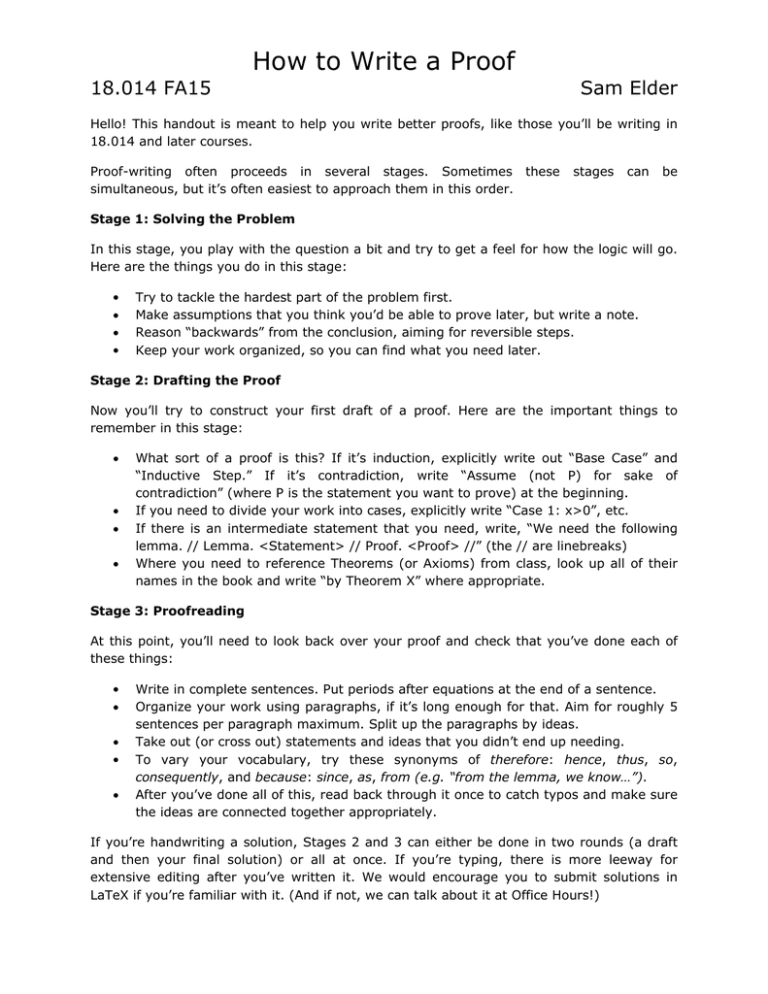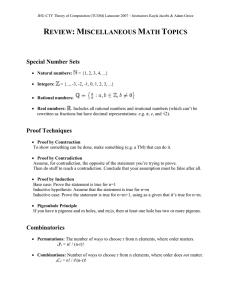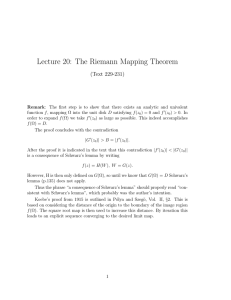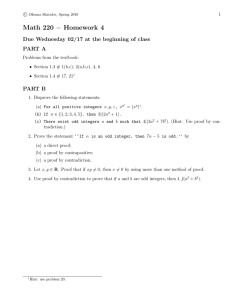How to Write a Proof 18.014 FA15 Sam Elder
advertisement

How to Write a Proof 18.014 FA15 Sam Elder Hello! This handout is meant to help you write better proofs, like those you’ll be writing in 18.014 and later courses. Proof-writing often proceeds in several stages. Sometimes these simultaneous, but it’s often easiest to approach them in this order. stages can be Stage 1: Solving the Problem In this stage, you play with the question a bit and try to get a feel for how the logic will go. Here are the things you do in this stage: x x x x Try to tackle the hardest part of the problem first. Make assumptions that you think you’d be able to prove later, but write a note. Reason “backwards” from the conclusion, aiming for reversible steps. Keep your work organized, so you can find what you need later. Stage 2: Drafting the Proof Now you’ll try to construct your first draft of a proof. Here are the important things to remember in this stage: x x x x What sort of a proof is this? If it’s induction, explicitly write out “Base Case” and “Inductive Step.” If it’s contradiction, write “Assume (not P) for sake of contradiction” (where P is the statement you want to prove) at the beginning. If you need to divide your work into cases, explicitly write “Case 1: x>0”, etc. If there is an intermediate statement that you need, write, “We need the following lemma. // Lemma. <Statement> // Proof. <Proof> //” (the // are linebreaks) Where you need to reference Theorems (or Axioms) from class, look up all of their names in the book and write “by Theorem X” where appropriate. Stage 3: Proofreading At this point, you’ll need to look back over your proof and check that you’ve done each of these things: x x x x x Write in complete sentences. Put periods after equations at the end of a sentence. Organize your work using paragraphs, if it’s long enough for that. Aim for roughly 5 sentences per paragraph maximum. Split up the paragraphs by ideas. Take out (or cross out) statements and ideas that you didn’t end up needing. To vary your vocabulary, try these synonyms of therefore: hence, thus, so, consequently, and because: since, as, from (e.g. “from the lemma, we know…”). After you’ve done all of this, read back through it once to catch typos and make sure the ideas are connected together appropriately. If you’re handwriting a solution, Stages 2 and 3 can either be done in two rounds (a draft and then your final solution) or all at once. If you’re typing, there is more leeway for extensive editing after you’ve written it. We would encourage you to submit solutions in LaTeX if you’re familiar with it. (And if not, we can talk about it at Office Hours!)











